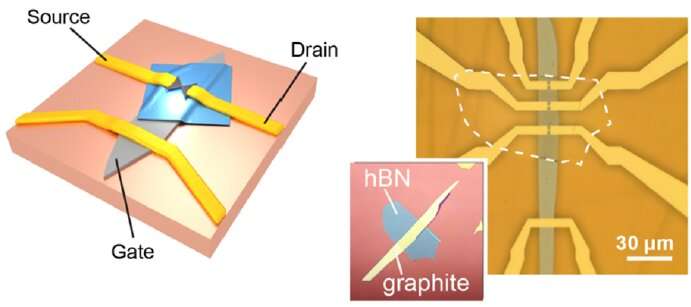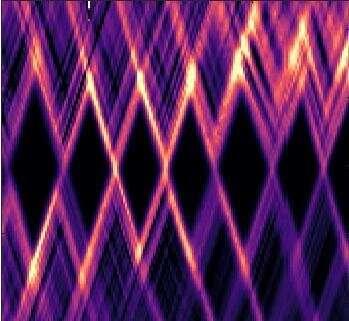Researchers create a mechanically tunable graphene quantum dot

Precisely manipulating individual charge carriers is a cornerstone for single-electron transistors and for electronic devices of the future, including solid-state quantum bits (qubits). Quantum dots (QDs) are at the heart of these devices. In a recent Nano Letters paper, researchers at Delft University of Technology (TU Delft) present the first mechanically tunable monolayer graphene QD whose electronic properties can be modified by in-plane nanometer displacements.
In order to access both the electrical and mechanical information from the sample, the researchers used a platform called the mechanically controlled break junction to measure the electromechanical properties of their device during three-point bending. The sample consists of a van der Waals heterostructure made by stacking several 2-D material flakes on top of a flexible substrate: a graphite back gate to electrostatically control the current through the device, a hexagonal boron nitride dielectric layer and a monolayer graphene conducting channel.
Breaking a bowtie
The results of the room-temperature measurements during bending demonstrate that the graphene, patterned into a nanobowtie shape with a constriction width of 160 nm, eventually breaks (zero current) but can also be remade (microampere currents) due to sliding and overlapping of the graphene edges. "We performed the same type of measurements at cryogenic temperatures (4K), and mapping the current as a function of the gate voltage and bias voltage revealed a clear diamond pattern." said lead author Sabina Caneva of TU Delft. "This means that a QD is present in the junction."
Strikingly, using nanoscale mechanical displacements, the researchers showed that both the capacitive and tunnel couplings of the QD to the graphene leads can be tuned in a fully reversible manner. "We achieved a five order of magnitude modulation of the tunnel coupling to the drain electrode, which is significantly higher than has been reported for QDs under solely electrical control," said Caneva. The device geometry allows the formation of a graphene bilayer overlap region, where the length of the overlap can be varied with sub-nm control by a mechanical tuning knob.
-

Credit: TU Delft -

Credit: TU Delft
Tuning the overlap
Importantly, this allowed the researchers to modify the asymmetry in the tunnel couplings by changing the overlap between the QD and the drain electrode. "Such a full and reversible manipulation of a graphene QD, in which the electrostatics and couplings can be controlled both mechanically and electronically, is unprecedented," said Pascal Gehring, last author of the paper. "These results are relevant for applications where a detailed understanding of the effect of tunneling asymmetry is crucial for device performance, such as in quantum calorimetry and in QD energy harvesters."
The MCBJ platform can be extended to other 2-D materials with the prospect of exploring the low-temperature transport behavior under electrical and mechanical influence. In particular, it can lend itself to the formation, rupture and controlled overlap of ultra-narrow constriction in superconducting thin films, thereby providing a novel approach to manipulating the Josephson effect in an in-plane device.
More information: Sabina Caneva et al. A Mechanically Tunable Quantum Dot in a Graphene Break Junction, Nano Letters (2020). DOI: 10.1021/acs.nanolett.0c00984
Journal information: Nano Letters
Provided by Delft University of Technology





















